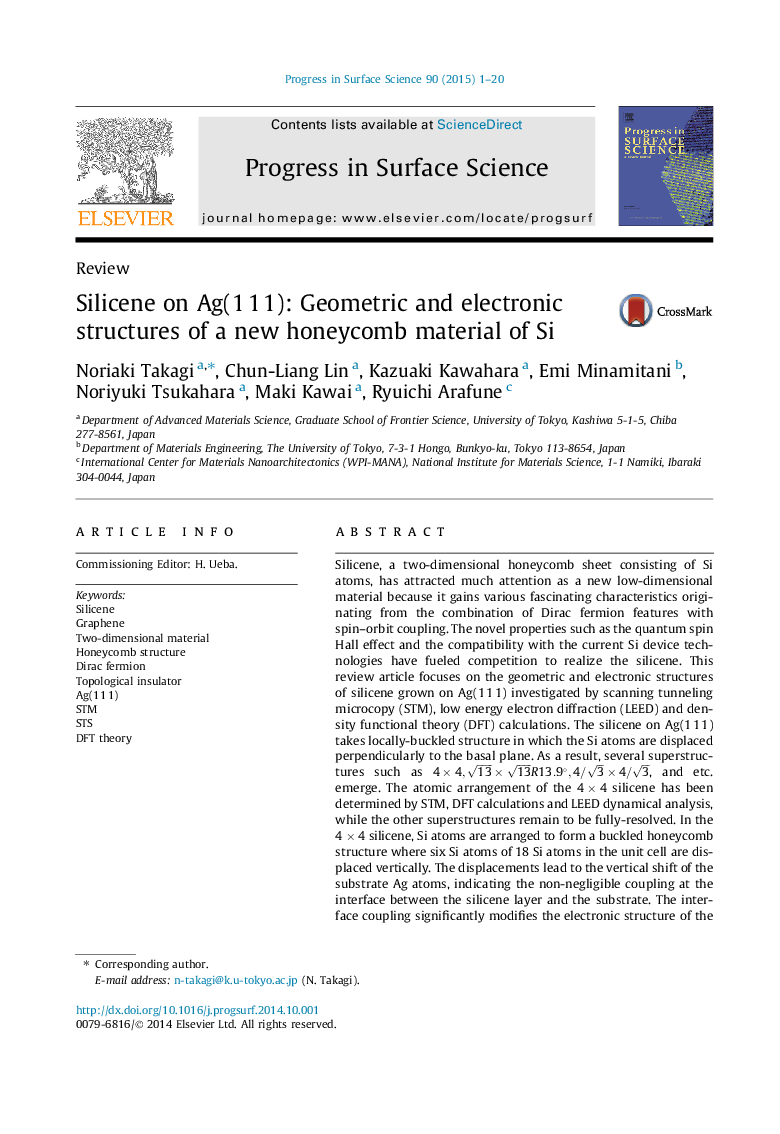| کد مقاله | کد نشریه | سال انتشار | مقاله انگلیسی | نسخه تمام متن |
|---|---|---|---|---|
| 5419955 | 1395118 | 2015 | 20 صفحه PDF | دانلود رایگان |
عنوان انگلیسی مقاله ISI
Silicene on Ag(1Â 1Â 1): Geometric and electronic structures of a new honeycomb material of Si
دانلود مقاله + سفارش ترجمه
دانلود مقاله ISI انگلیسی
رایگان برای ایرانیان
کلمات کلیدی
موضوعات مرتبط
مهندسی و علوم پایه
شیمی
شیمی تئوریک و عملی
پیش نمایش صفحه اول مقاله

چکیده انگلیسی
Silicene, a two-dimensional honeycomb sheet consisting of Si atoms, has attracted much attention as a new low-dimensional material because it gains various fascinating characteristics originating from the combination of Dirac fermion features with spin-orbit coupling. The novel properties such as the quantum spin Hall effect and the compatibility with the current Si device technologies have fueled competition to realize the silicene. This review article focuses on the geometric and electronic structures of silicene grown on Ag(1 1 1) investigated by scanning tunneling microcopy (STM), low energy electron diffraction (LEED) and density functional theory (DFT) calculations. The silicene on Ag(1 1 1) takes locally-buckled structure in which the Si atoms are displaced perpendicularly to the basal plane. As a result, several superstructures such as 4Ã4,13Ã13R13.9°,4/3Ã4/3, and etc. emerge. The atomic arrangement of the 4 Ã 4 silicene has been determined by STM, DFT calculations and LEED dynamical analysis, while the other superstructures remain to be fully-resolved. In the 4 Ã 4 silicene, Si atoms are arranged to form a buckled honeycomb structure where six Si atoms of 18 Si atoms in the unit cell are displaced vertically. The displacements lead to the vertical shift of the substrate Ag atoms, indicating the non-negligible coupling at the interface between the silicene layer and the substrate. The interface coupling significantly modifies the electronic structure of the 4 Ã 4 silicene. No Landau level sequences were observed by scanning tunneling spectroscopy (STS) with magnetic fields applied perpendicularly to the sample surface. The DFT calculations showed that the Ï and Ïâ bands derived from the Si 3pz are hybridized with the Ag electronic states, leading to the drastic modification in the band structure and then the absence of Dirac fermion features together with the two-dimensionality in the electronic states. These findings demonstrate that the strong coupling at the interface causes the symmetry breaking for the 4 Ã 4 silicene and as a result the disappearance of Dirac fermion features. The geometric and electronic structures of other superstructures are also discussed.
ناشر
Database: Elsevier - ScienceDirect (ساینس دایرکت)
Journal: Progress in Surface Science - Volume 90, Issue 1, February 2015, Pages 1-20
Journal: Progress in Surface Science - Volume 90, Issue 1, February 2015, Pages 1-20
نویسندگان
Noriaki Takagi, Chun-Liang Lin, Kazuaki Kawahara, Emi Minamitani, Noriyuki Tsukahara, Maki Kawai, Ryuichi Arafune,